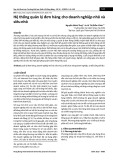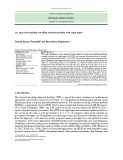
http://www.iaeme.com/IJMET/index.asp 978 editor@iaeme.com
International Journal of Mechanical Engineering and Technology (IJMET)
Volume 10, Issue 03, March 2019, pp. 978-989. Article ID: IJMET_10_03_098
Available online at http://www.iaeme.com/ijmet/issues.asp?JType=IJMET&VType=10&IType=3
ISSN Print: 0976-6340 and ISSN Online: 0976-6359
© IAEME Publication Scopus Indexed
PROPOSAL OF AN APPROACH TO IMPROVE
BUSINESS PROCESSES OF A SERVICE SUPPLY
CHAIN
Houda Mezouar
ENSIAS/Mohammed V University of Rabat, Rabat, Morocco,
Abdellatif El Afia
ENSIAS/Mohammed V University of Rabat, Rabat, Morocco,
ABSTRACT
The purpose of this paper is to develop an approach to analyze and improve business
processes of a service supply chain (SSC), through a real case study. Within this
framework, the paper suggests an approach based on the DMAIC (Define-Measure-
Analyze-Improve-Control) method of Six Sigma - that combined Business Process
Management (BPM), Supply Chain Operations Reference (SCOR), root cause analysis
tree diagram, and Characteristics of Smart Supply chain - to improve one chosen
business process of the Moroccan retirement supply chain. Based on this case study, the
paper shows that the suggested approach identifies the malfunctioning causes for the
studied business process, improves its behavior and manages its control. The approach
is detailed, and it combines methods which are not complicated, so it can be used by
academics and organization's managers. More case studies can be used to more
thoroughly evaluate the presented approach.
Keywords: BPM, Business process, SCOR, Smart supply chain, Service supply chain
Cite this Article: Houda Mezouar and Abdellatif El Afia, Proposal of An Approach to
Improve Business Processes of a Service Supply Chain, International Journal of
Mechanical Engineering and Technology, 10(3), 2019, pp.978-989
http://www.iaeme.com/IJMET/issues.asp?JType=IJMET&VType=10&IType=3
1. INTRODUCTION
In the light of the increasing attention on SSC by both practitioners and academics, [1] and [2]
defined it as a gigantic supportive subsystem in massive sustainable processes and uses of
resources, which induce the management to attention and design on their sustainable service
development. In a simpler way, [3] and [4] pointed out that an SSC is a systematic sequence of
professional, clerical, and technical services explicitly set up to provide specific services, such
as producing a financial product, designing a house, or managing a retirement scheme. In
Morocco as in most countries, the retirement is one of the services that attract the citizens’

Houda Mezouar and Abdellatif El Afia
http://www.iaeme.com/IJMET/index.asp 979 editor@iaeme.com
attention since the beginning of their careers [5]. It is provided by six organizations. The
Moroccan Pension Fund (MPF) manages a compulsory scheme for the incumbent employers
of the state (civilian and military). The private sector employees benefit from a compulsory
retirement scheme managed by The National Social Security Fund (NSSF). The Moroccan
Inter-professional Fund of Retirement (MIFR) manages a voluntary supplementary scheme for
private sector employees. The Collective Retirement Allowance Scheme (CRAS) manages a
compulsory scheme for the staff of public establishments and temporary employees of local
authorities. In addition to two internal funds, managed by the Bank Al-Maghrib and by the
National Office of Water and Electricity. The schemes provided by MPF are the civil pension
scheme, the military pension scheme, the supplementary pension scheme ATTAKMILI, and
the non-contributory pension schemes. The service addressed in this paper, is the management
of the civil pension scheme provided by MPF. The retirement field faces two main challenges,
the first one is the need to make this system last longer. The other challenge is the difficulty of
managing the continuity between the salary and the retirement pension, in other words, the
difficulty of offering this service (the civil retirement pension) to the customer (the pensioner)
at the right time (the first month of the retirement). This work focuses on the second one from
a SSC angle, which provides us an overall analysis of this SSC, and consequently enables us to
put strategies to address the main causes of discontinuity for the studied SSC. The proposed
approach in this work is based on DMAIC which the problem-solving methodology behind Six
Sigma that is have been derived from Deming’s improvement cycle namely Plan-Do-Check-
Act (PDCA). The reputations of the Six Sigma DMAIC method are gained by identifying
defects and insinuate their root cause [6]. In the first phase a modelling method based on SCOR
and Business Process Model and Notation (BPMN) is used, this method has been already used
to give an overall overview of other supply chains, in [7] and [8] it was used to analyze the
supply chain of electricity. In the Measure phase, we simulate the BPMN model of the previous
phase using Bonita BPM. In the third phase, we analyze the results of the simulation and present
the root cause analysis tree diagram. In the Improve phase, we took advantage of the smart
supply chain characteristics presented in [9] to deal with the causes identified in the previous
phase. In the last phase, based on the simulation results and the SCOR Key Performance
Indicators (KPI), we elaborate a dashboard composed of steering and performance indicators,
to maintain the control of the business process behavior. The remainder of this paper is
organized as follows. Section 2 gives an overall overview about the SSC, business processes
and Six Sigma methodology. The following section clarifies the proposed approach for the
performance evaluation of the studied SSC. The obtained results are explained in Section 4.
Finally, Section 5 is a conclusion that synthesizes the achieved work.
2. BACKGROUND
With the growing importance of the service sector in economies, the notion of SSC has obtained
a more prominent role in contemporary operations management, as more and more traditionally
product-based companies like IBM, Cisco and Pitney Bowes garner increasing proportions of
their revenues from services [10]. And, in light of the increasing attention on SSC by both
practitioners and academics, [11] defines the SSC as “a structured set of competencies that
constitute proactive, relational, coordinating people and technology dimensions desired to
deliver specific service offerings”. By way of explanation, a SSC is a set of processes involved
in moving a service from supplier to customer. Those processes are defined as a set of 7Ts
(talents, tasks, teams, techniques, technology, time, tools) arranged in a particular way to
transform a set of inputs into a specified set of outputs (goods or services) [12]. In other words,
and according to [13] a process is used to represent a set of tasks that are required to occur in
an agreed sequence in order to achieve an outcome. The processes can be categorized into core
processes, support processes, and management processes [14]. Moreover, the word “business

Proposal of An Approach to Improve Business Processes of a Service Supply Chain
http://www.iaeme.com/IJMET/index.asp 980 editor@iaeme.com
process” is used when the process accomplishes a specific organizational goal, in this work the
service in matter is “the retirement”, and the studied business process is “the management of
civil pension rights” of the Moroccan retirement SSC. Business Process Improvement (BPI)
encompasses a spectrum of activities, methods and approaches that seek to improve the
effectiveness and efficiency of business processes over time and ensure the alignment of
business processes with the competitive environment [15]. Numerous methods for BPI projects
were proposed including benefit and effort analysis, cost-benefit analysis, Pareto charts, cause-
effect matrix, Pareto priority index, theory of constraints, six-sigma analysis, brainstorming
[16]. In this work, the adopted method is the six-sigma analysis. The name Six Sigma refers to
the proportion of defects, or errors, in a process [17]. It is a well-established approach that seeks
to identify and eliminate defects, mistakes or failures in business processes or systems by
focusing on those process performance characteristics that are of critical importance to
customers [18]. Thanks to its flexibility, Six Sigma application is not limited only to
manufacturing but can be extended to the whole supply chain which includes the provision of
services [19]. It has been exploited by many world class organizations such as General Electric,
Motorola, Honeywell, Bombardier, ABB, Sony, to name a few from the long list [20]. In the
service sector, it has been embraced by many big service-oriented companies such as J P
Morgan, American Express, Lloyds TSB, Egg, City Bank, Zurich Financial Services, BT, etc
[20]. The literature on Six Sigma is entirely consistent regarding the argument that one of the
critical success factors for the successful implementation of Six Sigma is project selection [21].
Reference [22], explained the benefits of six sigma in service organizations, by offering as an
example the results of a six-sigma pilot survey in UK service organizations, it highlighted the
most common challenges and implementation issues of six sigma application in SSC. In fact,
the approach is applied in different fields all over the word. It was successfully applied to AV
systems resulting in an increase in overall test and sample AV by >90%, improved turn-around
time, reduced time for manual verification, and with no obvious compromise to quality or error
detection [23]. Reference [24], used six sigma methodologies to solve the problem in oil
classification extracted from the complex mixtures of oil spilled dataset. The analysis of six
sigma link with the quality engineering improved the organizational performance to achieve its
objectivity of the environmental forensics. In medical field, [25] used six sigmas as a tool in
saving hospital money, resulting in better patient outcomes, while [26] implemented six sigmas
in a radiotherapy department, allowing to redesign the breast repositioning matching procedure.
Within the same framework, [27] used six sigmas to guide improvement decisions, in which
authors target the reduction of overcrowding in emergency departments with a special attention
on the medical equipment utilization and the influence of changing the medical equipment
technology on patients’ waiting time and consequently their satisfaction. In the automotive
industry, [28] adopted Six Sigma to implement some improvement procedures whose resulted
in a significant financial impact on the company’s quality expenses. In Railway Companies,
[29] used six sigmas as a quality management tool to enhance the quality of services provided
in railway transport. The next section explains the approach proposed in this work to improve
the performance of the studied SSC business process.
3. THE PORPOSED APPROACH
The research was developed based on the case study of the management of the civil retirement
scheme, of the MPF. The data for this research was obtained from the IT department of the
MPF. The performance methodology used is Six Sigma, which helps improve the process
through finding the relations between inputs and outputs and controlling outputs using the
identified relations [30]. This methodology brings structure to process improvement by
providing the user with a more detailed outline of Deming’s PDCA cycle by guiding the
initiative through a five-stage cycle known as DMAIC [31], which actually stands for the phases

Houda Mezouar and Abdellatif El Afia
http://www.iaeme.com/IJMET/index.asp 981 editor@iaeme.com
of the improvement projects Define, Measure, Analyze, Improve and Control [32]. The first
phase ‘Define’ is done in [5], the authors models the studied service supply chain according to
a methodology in fourth levels organized in a descending order (that is, from the overall system,
to decompose the latter into finer granularity subsystems), the three first levels are done with
SCOR and the last one is done with the BPMN. The last level represents the modelling of the
studied business process ‘the management of civil pension rights’, in this work the same model
is cited, because it is the basis of the other phases. The second phase ‘Measure’ represents the
simulation of the aforementioned model using Bonita BPM, the used load profile and business
subject are detailed bellow. In the third phase ‘Analyze’, the results of the simulation are
analyzed and presented in a root cause analysis tree diagram. In the fourth phase ‘Improve’, we
take advantage of the principles of Smart Supply Chain presented in [9] to improve the process
of the first phase. For the last phase ‘Control’, based on the simulations’ results analysis and
the SCOR KPI, a dashboard is elaborated to control the performance of this SSC.
4. RESULTS
4.1. Define phase
This phase of DMAIC analysis was done in [5] according to a top down modelling methodology
in four levels. The strategic, the tactical, and the operational levels, are done with SCOR, the
last one the real-time level focuses on the business process “the management of civil pension
rights”, it’s done with BPMN using the software Bonita BPM as shown in Figure 1. This process
is composed of six lanes: “head of career tracking service”, “Dispatching”, “Affiliation”,
“Contribution”, “Liquidation”, and “Concession”. It has one start event which is "receive
folders", and three end events: "folder sent to the organization", "Non-compliant folder", or
"conceded folder". Once the reception of folders is done, the head of career service assign them
to the affiliation officers, and then he designates a monitoring agent to manage the processing
of folders, he starts by dispatching the folders to the assigned officers. The affiliation officer
studies the folder, if the folder is not complete (all papers are not received) he rejects it, if not
he validates it, and then he certifies the affiliation data before printing the certification sheet.
And then he sends the certified folder with its certification sheet to the concerned contribution
officer and a copy of it to the monitoring agent. Once the contribution officer receives the folder,
he verifies the affiliation certification, if it is valid, he certifies the contribution, if not he rejects
the certification. The liquidator studies the certified folder (affiliation and contribution), if it is
not valid, he reject the folder. If a folder is rejected before the certification or the liquidation,
the monitoring agent establishes a rejection letter to describe the rejection causes; this letter is
signed by the head of career service before being send to the concerned organization. For each
rejected folder, once it is sent to the organization, the management of civil pension rights ends
by executing the error end event "folder sent to the organization". For the valid certified folder,
the liquidator verifies the compliance with the rights, if this compliance is not valid, he rejects
the folder, in this case the management of civil pension rights ends by executing the error end
event “Non-compliant folder”. For the folders with valid rights compliance, the liquidator
validates the legal conditions, and then he runs the liquidation via the system (which will
calculate the pension amount and generate a pension number) before printing the liquidation
report, then he sends the folder for verification to the verifier. In case the verifier rejects the
liquidation, the liquidator reviews the folder and repeats the liquidation operation until it is
validated by the verifier. Once the verifier validates the liquidation, he concedes the folder
(which will generate a decision number) and finally generates the decision. In this case the
management of civil pension rights ends by executing the end event “conceded folder”.

Proposal of An Approach to Improve Business Processes of a Service Supply Chain
http://www.iaeme.com/IJMET/index.asp 982 editor@iaeme.com
Figure 1 the management of civil pension rights’ process of the 4th level of the SSC of retirement
4.2. Measure phase
In this step we take advantage of BPM which is both a management discipline and a set of
technologies aimed at automating organizations’ key business processes, as defined in [33], to
execute the simulation. Simulation can be applied for different purposes, namely prediction,
performance, entertainment, training, education, confirmation and discovery [34]. In this phase,
it is applied to determine how the process currently performs. When a simulation is run, a
specified number of iterations over a specified period of time are run either with simulated data
or with assigned probabilities. The load profile used in this work is composed of the start date
01-06-2018 at 08:30 am, the end date 31-12-2018 at 04:30 and 100 instances. The objective is
to simulate the case of affiliates who are going to retire in the end of the year 2018. Giving that
the affiliate’s administrations have to send their folders six months before their retirement, we
choose the start date on June 2018. It is considered that a folder is received late if the reception
date is greater than the retirement date minus 3 months, in our case, a folder is late if it is
received after September 30, 2018. A received folder may be complete or incomplete (lack of
a files), and during its processing, a folder may not be subject to a revision, or it may be subject
to more than one revision. In this study we choose five as a maximum possible number of
revisions. So, to characterize a folder, we create the business object ‘dossierState’ (LONG
bonitaBPMid; DATE receptionDate; BOOLEAN complete; INTAGER revisionNbr;). Six
scenarios are considered, as shown in Table 1. In keeping with our profile, we considered a date
that meets the deadlines, and one that represents a late reception, we also considered whether









![Quy trình, trình tự công việc nhân viên bán hàng hằng ngày [chuẩn nhất]](https://cdn.tailieu.vn/images/document/thumbnail/2019/20190827/xylitolcool/135x160/2841566889734.jpg)







![Đề kiểm tra Quản trị logistics [mới nhất]](https://cdn.tailieu.vn/images/document/thumbnail/2025/20251015/2221002303@sv.ufm.edu.vn/135x160/35151760580355.jpg)
![Bộ câu hỏi thi vấn đáp Quản trị Logistics [năm hiện tại]](https://cdn.tailieu.vn/images/document/thumbnail/2025/20251014/baopn2005@gmail.com/135x160/40361760495274.jpg)







